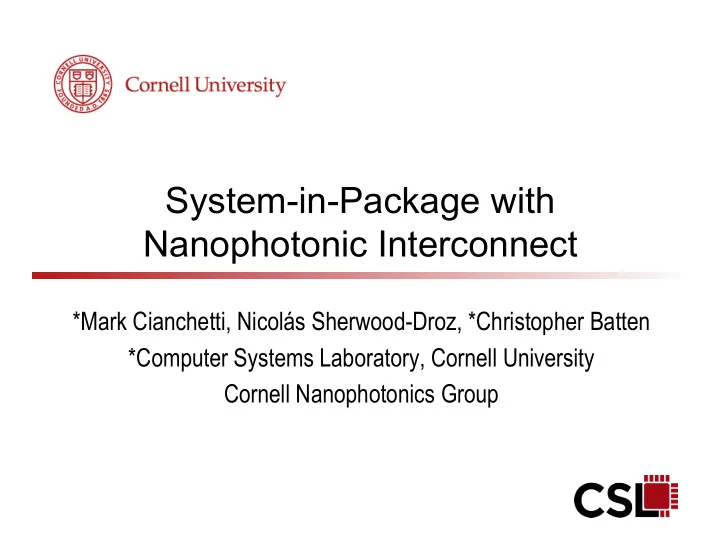

System-in-Package with Nanophotonic Interconnect *Mark Cianchetti, Nicolás Sherwood-Droz, *Christopher Batten *Computer Systems Laboratory, Cornell University Cornell Nanophotonics Group
Electrical System-in-Package � MultiChip Module (MCM) • Joins multiple dies across a shared substrate � Interconnect has lower performance and power efficiency than monolithic alternatives
Nanophotonic System-in-Package � An NSiP contains nanophotonic chiplets and standard electrical chips � Nanophotonics provides high-speed, power efficient inter-die interconnect
NSiP Versus SiP � High inter-die communication bandwidth through nanophotonics • Competitive with bisection bandwidth available on-chip � Improved power efficiency over electrical communication
Talk Outline
NSiP Integration Classes � Monolithic disintegration • Monolithic SoC divided into multiple small chips � Macrochip integration • Permits fabrication of systems with total area beyond reticle size limitations
ADV1: NSiP Enabled Systems � NSiP enables systems not possible with SoC • Mixed process technology for increased customization • Macrochip integration (SoCs above reticle limit)
ADV2: Reduced NRE Costs � Off-the-shelf (OTS) chiplet composition • Eliminates initial NRE overhead � Economical for low to mid production volume
Custom Chiplet Fabrication � NSiP consists of three OTS chiplets and one custom chiplet � Custom fabricated chiplet incurs an upfront NRE overhead
ADV3: Reducing Marginal Costs � NSiP has a lower marginal cost at high defect densities • May be beneficial if future processes result in significantly lower yields � Speed binning for system yield improvement
Expected Defect Densities
Talk Outline
NSiP Device-Level Strategy � Back-end-of-line (BEOL) nanophotonic technology • Devices can be deposited on chips fabricated in different processes � BEOL device materials • Deposited poly-silicon rings • Multi-layer silicon-nitride waveguides • Germanium photodetectors � Development of NSiP prototype • Chiplets fabricated in standard CMOS foundry • Nanophotonic devices deposited in an academic research lab
BEOL Technology
Talk Outline
NSiP System-Level Strategy � Chiplets are interconnected in a 2-fly flattened butterfly topology • Minimizes inter-chiplet communication latency • Minimizes optical coupling losses � Scaling NSiP to larger number of processors • Increase topology radix or add second butterfly stage
NSiP Implementation � Chiplets contain nanophotonic transmitters and receivers � Centralized hub chip passively shuffles wavelengths between chiplets • Thermally isolated and optimized for nanophotonic devices
Talk Outline
Tightly Coupled Adaptive Routing � Universal globally adaptive load-balanced routing (UGAL) • Minimal routing under low traffic load • Valiant’s routing through a random node under high traffic load � NSiP topology provides tightly coupled congestion feedback • Every router is connected to the others � We propose to use UGAL with global information (UGAL-GI) • Adaptive decision is based on feedback from all other network routers
Example: UGAL Vs. UGAL-GI � UGAL-GI has a 25% improvement in saturation throughput
Conclusions � SiP has three key advantages over SoC • Macrochip and mixed process systems • OTS composition for reduced NRE – OTS composition with custom design • Speed binning for increased yield � NSiP overcomes the performance and energy limitations of SiP � Future Work • Small proof-of-concept NSiP prototype • Modeling larger number of chiplets
Recommend
More recommend